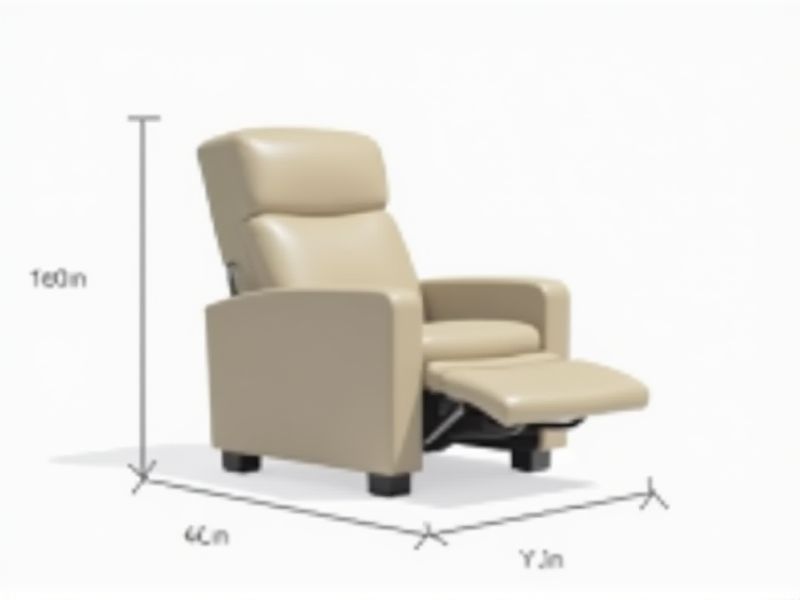
When selecting a reclining chair, knowing the standard dimensions can help you ensure it fits comfortably in your space. Most reclining chairs are about 32 to 40 inches wide, 37 to 41 inches deep, and stand roughly 39 to 43 inches tall when upright. When fully reclined, the depth usually extends to between 60 and 70 inches, so you'll want to make sure you have enough clearance behind and in front of the chair. Always check the manufacturer's specifications for exact measurements, as dimensions can vary by style and brand.
Seat Width
A reclining chair's seat width typically ranges from 20 to 24 inches, catering to various body types for optimal comfort. An ideal seat width ensures that individuals can sit comfortably without feeling constricted, enhancing the overall reclining experience. For you, a chair with adequate seat width not only promotes better posture but can also alleviate pressure on the hips and thighs. When selecting a reclining chair, consider the seat width as a key factor in providing long-lasting comfort and support.
Seat Depth
Seat depth for reclining chairs typically measures between 18 to 22 inches, ensuring comfort and support for various body types. A deeper seat can facilitate a more relaxed position, while a shallower seat promotes better posture for users. When choosing a reclining chair, consider your leg length; a chair with an appropriate seat depth allows your feet to rest comfortably on the floor. Testing the seat depth in-store or checking specifications online can help you select the perfect chair for your needs.
Seat Height
The ideal seat height for a reclining chair typically ranges from 17 to 20 inches from the floor, ensuring comfort and accessibility for most users. An ergonomic seat height allows your feet to rest flat on the ground, promoting proper posture and reducing strain on your legs and back. Many reclining chairs also feature adjustable seating options, which can accommodate various body types and preferences. When selecting a reclining chair, consider these height specifications to enhance your overall sitting experience.
Backrest Height
The standard backrest height for a reclining chair typically ranges from 28 to 32 inches, ensuring optimal support for your spine and neck. This height caters to a variety of user heights, accommodating individuals from 5'2" to 6'2". Proper backrest height is crucial for reducing strain during extended periods of use, promoting better posture and comfort. When selecting a reclining chair, consider models that offer adjustable backrest features to tailor the support to your specific needs.
Armrest Height
The ideal armrest height for a reclining chair is typically between 6 to 12 inches above the seat surface, providing optimal support for your arms and shoulders. A proper armrest height reduces the strain on your neck and back during prolonged seating, enhancing overall comfort. Many ergonomic models feature adjustable armrests, allowing customization to suit individual preferences and body types. When selecting a reclining chair, ensure you test the armrest height to achieve the best alignment for your posture.
Chair Length When Reclined
The chair length when fully reclined typically ranges from 65 to 75 inches, which accommodates users of various heights comfortably. A well-designed reclining chair should also feature an adjustable backrest to enhance ergonomic support during relaxation. Many models incorporate a footrest that extends automatically when the chair is reclined, ensuring optimal leg support. When selecting your reclining chair, consider the total length to fit seamlessly in your living space while maximizing comfort.
Footrest Length
The standard footrest length for a reclining chair typically ranges between 16 to 20 inches, offering optimal comfort and support for users of varying heights. Proper footrest length plays a crucial role in reducing strain on your legs and improving blood circulation during extended periods of sitting. Many ergonomic designs allow for adjustable footrests. Ensuring the footrest aligns with your natural leg position can significantly enhance your overall relaxation experience.
Chair Width When Fully Reclined
The standard width of a fully reclined chair typically ranges from 26 to 36 inches, depending on the design and manufacturer. This measurement ensures comfort and accessibility, accommodating a variety of body types and preferences. It's essential to consider your space; for optimal use, the chair should fit into the designated area without restricting movement. Prioritizing chair width will enhance your reclining experience, providing the necessary support for relaxation.
Weight Capacity
The standard weight capacity for most reclining chairs typically ranges between 250 to 350 pounds, ensuring durability and support for a variety of users. When selecting a reclining chair, it's essential to consider this weight limit, as exceeding it may compromise the chair's structural integrity and comfort. Many models are designed with robust materials, such as reinforced steel frames and high-density foam cushions, to enhance longevity and user experience. Your choice of a reclining chair should align with these specifications to ensure safety and satisfaction.
Distance From The Wall For Reclining
Reclining chairs typically require a minimum distance of 6 to 12 inches from the wall to function correctly, allowing the backrest to fully recline without obstruction. This standard distance ensures that you can enjoy a comfortable reclining experience without damaging either the chair or your walls. When choosing a reclining chair, consider the space available in your room; a larger chair may need more clearance. Proper positioning not only enhances comfort but also prolongs the lifespan of the chair by minimizing wear and tear on its mechanisms.
